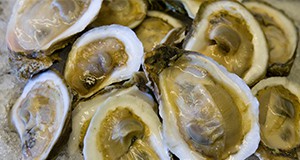 Vibrio vulnificus occurs naturally in warm brackish and saltwater environments. During the warmer months, this bacterium can reach particularly high concentrations in filter-feeding shellfish that inhabit coastal waters. Foodborne illness from V. vulnificus is almost exclusively associated with consumption of raw oysters. This 3-page fact sheet is a major revision that discusses risk of infection, times to seek medical treatment, symptoms, activities related to illness, foods commonly associated with the bacterium, handling and storage of seafood and shellfish, and methods of prevention. Written by Anita C. Wright, Renée M. Goodrich, Michael A. Hubbard, and Keith R. Schneider, and published by the UF Food Science and Human Nutrition Department. Original publication date: July 2009. Revised October 2015.
Vibrio vulnificus occurs naturally in warm brackish and saltwater environments. During the warmer months, this bacterium can reach particularly high concentrations in filter-feeding shellfish that inhabit coastal waters. Foodborne illness from V. vulnificus is almost exclusively associated with consumption of raw oysters. This 3-page fact sheet is a major revision that discusses risk of infection, times to seek medical treatment, symptoms, activities related to illness, foods commonly associated with the bacterium, handling and storage of seafood and shellfish, and methods of prevention. Written by Anita C. Wright, Renée M. Goodrich, Michael A. Hubbard, and Keith R. Schneider, and published by the UF Food Science and Human Nutrition Department. Original publication date: July 2009. Revised October 2015.
http://edis.ifas.ufl.edu/fs147
Tag: Michael A. Hubbard
Preventing Foodborne and Non-foodborne Illness: Vibrio parahaemolyticus
 Vibrio parahaemolyticus is a naturally occurring bacterium that inhabits coastal brackish marine waters throughout the world and is commonly found in the United States and Canada. If ingested in sufficient numbers, this bacterium can cause illness such as gastroenteritis with symptoms such as cramps, vomiting, and nausea. Illnesses linked with this organism are usually associated with the consumption of raw or improperly cooked seafood, particularly raw oysters. This 3-page fact sheet is a major revision that discusses Vibrio parahaemolyticus, illness caused by the bacterium, factors that increase risk of infection, methods of infection, seafood and shellfish handling recommendations, and prevention. Written by Anita C. Wright, Renée M. Goodrich, Michael A. Hubbard, and Keith R. Schneider, and published by the UF Department of Food Science and Human Nutrition. Original publication date: July 2009. Revised October 2015.
Vibrio parahaemolyticus is a naturally occurring bacterium that inhabits coastal brackish marine waters throughout the world and is commonly found in the United States and Canada. If ingested in sufficient numbers, this bacterium can cause illness such as gastroenteritis with symptoms such as cramps, vomiting, and nausea. Illnesses linked with this organism are usually associated with the consumption of raw or improperly cooked seafood, particularly raw oysters. This 3-page fact sheet is a major revision that discusses Vibrio parahaemolyticus, illness caused by the bacterium, factors that increase risk of infection, methods of infection, seafood and shellfish handling recommendations, and prevention. Written by Anita C. Wright, Renée M. Goodrich, Michael A. Hubbard, and Keith R. Schneider, and published by the UF Department of Food Science and Human Nutrition. Original publication date: July 2009. Revised October 2015.
http://edis.ifas.ufl.edu/fs146
FSHN09-01/FS146 Preventing Foodborne and Non-foodborne Illness: Vibrio parahaemolyticus
FSHN09-01, a 3-page fact sheet by Anita C. Wright, Renée Goodrich Schneider, Michael A. Hubbard, and Keith R. Schneider, describes this bacterium that occurs naturally in coastal waters throughout the world and is linked to illnesses associated with consumption of raw or improperly cooked seafood — type of illness, who is at risk of infection, how common infections are, how they occur, how to receive and store seafood and shellfish, and methods to prevent infection in high-risk individuals. Includes references. Published by the UF Department of Food Science and Human Nutrition, July 2009.
http://edis.ifas.ufl.edu/FS146
FSHN0521/FS126 Agroterrorism in the U.S.: An Overview
Revised! FSHN-05-21, a 4-page fact sheet by R. Goodrich Schneider, K.R. Schneider, C.D. Webb, M. Hubbard, and D.L. Archer, discusses the use of biological agents in a deliberate, harmful attack, or terrorism using the weapons of biological warfare against the U.S. agricultural and food processing system. Includes references. Published by the UF Department of Food Science and Human Nutrition, April 2009.
http://edis.ifas.ufl.edu/FS126
FSHN0518/FS129 Preventing Foodborne Illness: Norovirus
Revised! FSHN-05-18, a 4-page fact sheet by Keith R. Schneider, Renée Goodrich Schneider, Mike Hubbard, and Riya Shukla, provides essential information about noroviruses in a question-and-answer format. Includes references. Published by the UF Department of Food Science and Human Nutrition, April 2009.
http://edis.ifas.ufl.edu/FS129